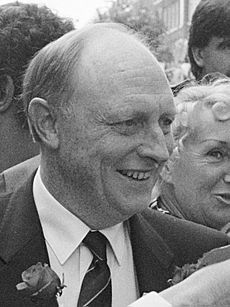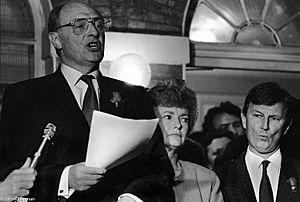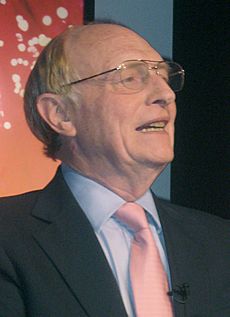Neil Kinnock facts for kids
Quick facts for kids
The Lord Kinnock
|
|
|---|---|
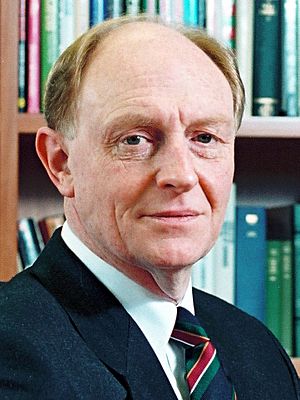
Official portrait, 1995
|
|
| Vice-President of the European Commission | |
| In office 16 September 1999 – 21 November 2004 Serving with Loyola de Palacio
|
|
| President | Romano Prodi |
| European Commissioner for Administrative Reform | |
| In office 16 September 1999 – 21 November 2004 |
|
| President | Romano Prodi |
| Preceded by | Erkki Liikanen |
| Succeeded by | Siim Kallas |
| European Commissioner for Transport | |
| In office 16 February 1995 – 16 September 1999 |
|
| President | Jacques Santer Manuel Marín (acting) |
| Preceded by | Karel Van Miert |
| Succeeded by | Loyola de Palacio |
| Leader of the Opposition | |
| In office 2 October 1983 – 18 July 1992 |
|
| Monarch | Elizabeth II |
| Prime Minister | Margaret Thatcher John Major |
| Preceded by | Michael Foot |
| Succeeded by | John Smith |
| Leader of the Labour Party | |
| In office 2 October 1983 – 18 July 1992 |
|
| Deputy | Roy Hattersley |
| Preceded by | Michael Foot |
| Succeeded by | John Smith |
| Shadow Secretary of State for Education and Science | |
| In office 14 July 1979 – 2 October 1983 |
|
| Leader | James Callaghan Michael Foot |
| Preceded by | Gordon Oakes |
| Succeeded by | Giles Radice |
| Member of the House of Lords | |
| Life peerage 28 January 2005 |
|
| Member of Parliament for Islwyn Bedwellty (1970–1983) |
|
| In office 18 June 1970 – 20 January 1995 |
|
| Preceded by | Harold Finch |
| Succeeded by | Don Touhig |
| Personal details | |
| Born |
Neil Gordon Kinnock
28 March 1942 Tredegar, Wales |
| Political party | Labour |
| Spouse | |
| Children | 2, including Stephen |
| Alma mater | Cardiff University |
| Signature | |
Neil Gordon Kinnock, Baron Kinnock (born 28 March 1942) is a Welsh politician. He was the leader of the Labour Party and the Leader of the Opposition in the UK from 1983 to 1992.
He was a Member of Parliament (MP) for 25 years, from 1970 to 1995. Later, he became a European Commissioner and served as Vice-President of the European Commission from 1999 to 2004. In 2005, he became a member of the House of Lords, which is part of the UK Parliament.
Contents
Early Life and Education
Neil Kinnock was born in Tredegar, Wales, on 28 March 1942. He was an only child. His father, Gordon Herbert Kinnock, was a former coal miner who later worked as a labourer. His mother, Mary Kinnock, was a district nurse.
In 1953, at age eleven, Neil started his secondary education at Lewis School, Pengam. He then went to University College of South Wales and Monmouthshire in Cardiff (now Cardiff University). He graduated in 1965 with a degree in Industrial Relations and History. The next year, he earned a postgraduate diploma in education. Before becoming an MP, he worked as a tutor for the Workers' Educational Association.
In 1967, he married Glenys Kinnock. They had two children: a son, Stephen Kinnock (born 1970), who is now a Labour MP, and a daughter, Rachel (born 1971). Glenys Kinnock passed away in December 2023.
Becoming a Member of Parliament
In June 1969, Neil Kinnock was chosen by the Labour Party to run for the Bedwellty area in South Wales. This area later became Islwyn in 1983. He was first elected to the House of Commons on 18 June 1970.
When he became an MP, his father told him, "Remember Neil, MP stands not just for Member of Parliament, but also for Man of Principle."
After the Labour Party lost the 1979 general election, James Callaghan, the Labour leader, made Kinnock the party's spokesperson for education. Kinnock was known for his left-wing views. He gained attention for criticising Margaret Thatcher's government during the Falklands War in 1982.
Leading the Labour Party
First Years as Leader (1983–1987)
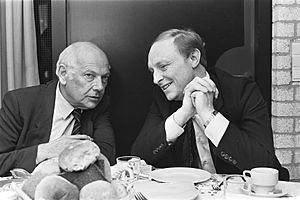
After Labour's big loss in the 1983 general election, Michael Foot resigned as leader. Neil Kinnock was elected as the new Labour Party leader on 2 October 1983, with 71% of the votes. Roy Hattersley became his deputy.
During his first years as leader, Kinnock worked to move the Labour Party towards the political centre. This was to improve its chances of winning future elections. He wanted to modernise the party and improve how it used the media. He also fought against extreme left-wing groups within the party.
Kinnock changed some of the party's older policies, like the idea of the government owning many industries. He focused on economic growth, which appealed to more people. He also accepted Britain's membership in the European Economic Community, a change from the party's previous stance.
He faced challenges, including a major miners' strike from 1984 to 1985. Kinnock supported the miners' cause but strongly disagreed with the tactics used by the union leader, Arthur Scargill. He publicly criticised the violence and the way the strike was handled.
In 1985, Kinnock gave a famous speech at the Labour Party conference. He criticised some left-wing councils for their actions, saying, "You can't play politics with people's jobs and with people's services or with their homes." This showed his determination to change the party's image.
By 1986, Labour's position seemed to get stronger. They had good results in local elections and improved their public image with a new rose emblem.
The 1987 General Election
In early 1987, Labour lost a by-election, which is a special election held for one seat. As the 1987 general election approached, Labour was worried about finishing third in the national vote.
However, Kinnock's team had improved Labour's communication strategy. They released a popular party election broadcast called "Kinnock: The Movie." This video showed Kinnock's 1985 speech and images of him and his wife, Glenys, in Wales. It aimed to show him as a family man and connect him with his Welsh roots.
On election day, Labour secured second place, but still lost to the Conservatives. The Conservatives kept a large majority in the House of Commons. However, Labour did gain twenty seats, which was a positive step.
Second Period as Leader (1987–1992)
After the 1987 election, Kinnock focused on reforming the Labour Party's policies to make it more electable. This included a "policy review" and public consultations called "Labour Listens."
In 1988, the party created a new statement of its goals, focusing on equality rather than just public ownership. They also changed their policy on nuclear weapons, moving away from unilateral nuclear disarmament. These changes aimed to make the party more appealing to a wider range of voters.
Kinnock faced a challenge for the party leadership from Tony Benn in 1988, but Kinnock won easily.
Labour's support grew significantly from 1989 to 1990. This was partly due to public anger over the "poll tax" introduced by the Conservative government. Labour won many local council elections and several parliamentary by-elections. In the 1989 European elections, Labour came first, which was the first time in fifteen years.
In December 1989, Kinnock changed Labour's policy on "closed shops," which were agreements that only union members could be hired. This was seen as a move away from traditional socialist policies and aimed to show that the party was not controlled by trade unions.
When Margaret Thatcher resigned as Prime Minister in November 1990, Kinnock called for an immediate general election. However, John Major became the new Prime Minister, and public support for the Conservatives increased.
The 1992 General Election
In the three years before the 1992 general election, Labour was often ahead in opinion polls. Many polls suggested that the election, held on 9 April 1992, would result in either a "hung parliament" (where no party has a clear majority) or a small Labour majority.
However, the Conservatives won a majority, though it was much smaller than before. Some observers felt that a large Labour Party rally in Sheffield, and Kinnock's performance there, might have put off some voters.
The day of the election, The Sun newspaper ran a famous front page with Kinnock and the headline 'If Kinnock wins today, will the last person to leave Britain please turn out the lights.' After the election, Kinnock blamed The Sun and other right-wing media for Labour's loss. The next day, The Sun ran the headline 'It's The Sun Wot Won It'.
Kinnock later said he half-expected to lose the 1992 election. After his defeat, he became a media personality, hosting a chat show and appearing on TV programmes.
After Parliament
Neil Kinnock announced his resignation as Labour Party leader on 13 April 1992. John Smith became his successor.
European Union Commissioner

In early 1995, Kinnock was appointed one of the UK's two members of the European Commission. This meant he left the House of Commons after 25 years. He first served as Transport Commissioner.
He had to resign with the rest of the Commission in 1999. He was then re-appointed to the Commission under a new President, Romano Prodi. He became one of the Vice-Presidents of the European Commission, responsible for administrative reform. His term ended in November 2004.
In February 2004, it was announced that Kinnock would become the head of the British Council. His son, Stephen, also became head of a British Council branch in Russia around the same time.
Becoming a Life Peer
On 28 January 2005, Neil Kinnock was made a life peer as Baron Kinnock, of Bedwellty. This meant he became a member of the House of Lords. He was introduced to the House of Lords on 31 January 2005.
Kinnock had previously been a critic of the House of Lords. He explained that he accepted the peerage for "practical political reasons," wanting to contribute to national discussions on topics like higher education and foreign policy.
Political Views
Welsh Identity and Devolution
Kinnock supports devolution for Wales, which means giving more power to a Welsh Assembly. Proposals for a Welsh Assembly were in the Labour Party's 1992 election plan when he was leader.
However, in 1979, he campaigned against devolution for Wales at that time. He later clarified that he supports the idea of devolution but felt the specific plan in 1979 did not address economic differences in the UK. In 2023, he supported a paper that outlined an expanded devolution plan for the whole UK.
Kinnock has often described himself as a unionist, meaning he supports the United Kingdom remaining united.
Brexit
Kinnock strongly opposed Brexit, which was the UK leaving the European Union. In 2018, he stated that leaving the EU would bring risks and costs. He believed that staying in the EU was vital for public services like the NHS. He suggested that the UK should either stop Brexit or try to reduce the damage by seeking membership in the European Economic Area.
Personal Life
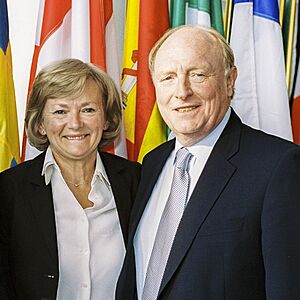
Neil Kinnock met Glenys Kinnock (née Parry) while they were studying at University College, Cardiff, in the early 1960s. They married on 25 March 1967. Glenys Kinnock was also a politician, serving as a UK Minister and a Member of the European Parliament. When she became a life peer in 2009, they became one of the few couples where both held titles in their own right.
They have a son, Stephen Kinnock, and a daughter, Rachel. Neil Kinnock's daughter-in-law is Helle Thorning-Schmidt, who was the Prime Minister of Denmark from 2011 to 2015.
Neil Kinnock is a fan of Cardiff City F.C. and often attends their matches. He also enjoys rugby union and supports the Wales national team.
He has been portrayed in satirical TV shows like Spitting Image and Have I Got News for You. In 2014, artist Edward Sutcliffe painted a portrait of Lord Kinnock.
Kinnock has described himself as an agnostic and an atheist. He is a Patron of Humanists UK.
See also
 In Spanish: Neil Kinnock para niños
In Spanish: Neil Kinnock para niños


